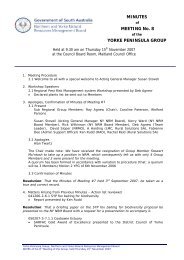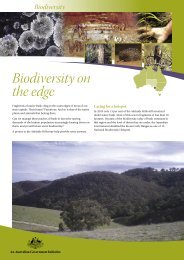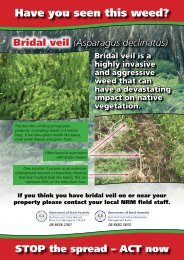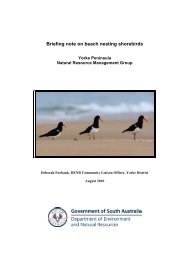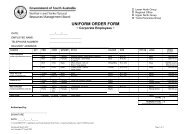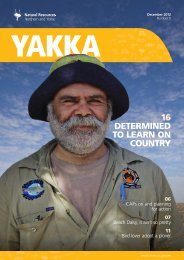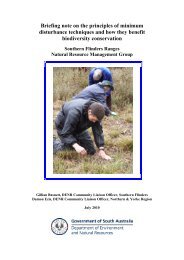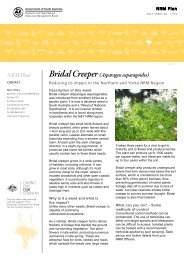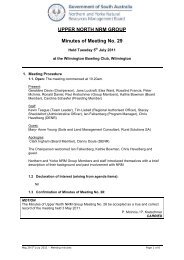Caring for country - Northern and Yorke Natural Resources ...
Caring for country - Northern and Yorke Natural Resources ...
Caring for country - Northern and Yorke Natural Resources ...
You also want an ePaper? Increase the reach of your titles
YUMPU automatically turns print PDFs into web optimized ePapers that Google loves.
4pest control<br />
Teams tackle pests<br />
The <strong>Northern</strong> <strong>and</strong> <strong>Yorke</strong> NRM Board<br />
is driving a l<strong>and</strong>scape scale control<br />
approach to protecting <strong>and</strong> restoring<br />
native habitat threatened by pest plants<br />
<strong>and</strong> animals.<br />
Across the Upper <strong>and</strong> Lower North <strong>and</strong> <strong>Yorke</strong><br />
Peninsula, the ef<strong>for</strong>t to increase native habitat<br />
has involved l<strong>and</strong>owners targeting infestations<br />
of rabbits, wheel cactus, gorse, blackberry,<br />
boneseed <strong>and</strong> bridal creeper.<br />
This coordinated program is supported by<br />
priority funding through the Australian<br />
Government’s <strong>Caring</strong> For Our Country<br />
initiative that aims to achieve <strong>and</strong> sustain an<br />
environment that is healthy, protected, wellmanaged<br />
<strong>and</strong> resilient.<br />
<strong>Natural</strong> biodiversity is dependent on the control<br />
of pests especially in <strong>and</strong> around areas of<br />
remnant native vegetation.<br />
In the Upper North, the program has<br />
particularly targeted rabbits <strong>and</strong> cactus<br />
infestations on public <strong>and</strong> private l<strong>and</strong>.<br />
Kevin Teague, the <strong>Northern</strong> <strong>and</strong> <strong>Yorke</strong> <strong>Natural</strong><br />
<strong>Resources</strong> Management (NYNRM) Board’s<br />
Upper North team leader, said rabbits had<br />
been a major problem <strong>for</strong> some years around<br />
Hawker, north east of Orroroo <strong>and</strong> in the<br />
Peterborough Council area.<br />
“L<strong>and</strong>owners have done all they can to stop<br />
the spread of rabbits, <strong>and</strong> the Board control<br />
program with funding support from <strong>Caring</strong><br />
For Our Country has been warmly welcomed,”<br />
Kevin said.<br />
“The l<strong>and</strong>owners have signed agreements to<br />
participate in the fully-funded rabbit control<br />
program. For their part, the l<strong>and</strong>owners<br />
provide warren spotters on motorbikes to<br />
identify sites to be ripped by contractors. This<br />
local knowledge also provides occupational<br />
health <strong>and</strong> safety support.<br />
“The agreements with l<strong>and</strong>owners also include<br />
a commitment to undertake follow-up control<br />
measures bearing in mind that we estimate that<br />
only one in 500 burrows becomes active again<br />
after ripping.”<br />
Kevin said contractors using bulldozers<br />
destroyed warrens that were mostly empty<br />
after rabbit calicivirus disease greatly reduced<br />
populations in late Spring.<br />
“The few rabbits that remained after the effects<br />
of calicivirus were then unable to enter their<br />
warrens to breed,” he said.<br />
Over summer, contractors destroyed 7,895<br />
warrens over 93,887 hectares of l<strong>and</strong>. This<br />
$130,000 control program was funded by<br />
the NYNRM Board through the Australian<br />
Government’s <strong>Caring</strong> For Our Country program<br />
<strong>and</strong> State Complementary Funding.<br />
Meanwhile, wheel cactus has been a<br />
widespread problem emanating from a core<br />
infestation near Parnaroo east of Peterborough.<br />
The NYNRM Board has coordinated two<br />
chemical cactus control programs. Under the<br />
first program, the Board provided $22,000 to<br />
chemically control 18,383 plants over 26,500<br />
hectares at no cost to l<strong>and</strong>holders.<br />
Secondly, the Board received $11,000 funding<br />
under the State Opuntia Task Force program to<br />
work with l<strong>and</strong>holders on the basis that they<br />
contribute 50 per cent of the cost either in time<br />
or money. More than 9,400 pest cactus plants<br />
were chemically injected over an area of 15,000<br />
hectares to significantly reduce the density of<br />
the infestation.<br />
In future under this arrangement, participating<br />
l<strong>and</strong>holders must commit to on-going<br />
controls, <strong>and</strong> contractors are providing training<br />
assistance on appropriate measures to eradicate<br />
the pest plant on their properties.<br />
Peter Mattey of Franklin Station near Terowie<br />
said there was a high level of cactus infestation<br />
in the region. With the NYNRM Board, he has<br />
invested in cactus control measures covering<br />
around 10,000 hectares <strong>and</strong> over 4,000<br />
hectares with part funding from the Murray<br />
Darling Basin NRM Board.<br />
“We are working at the extremities to stop the<br />
spread,” he said.<br />
In the Lower North, the NYNRM Board<br />
has been working with Greening Australia<br />
<strong>and</strong> l<strong>and</strong>holders to identify sites of rabbit<br />
infestation.<br />
Contractors have been engaged to carry out<br />
selective baiting programs <strong>and</strong> some warren<br />
ripping across an area encompassing Avon, Port<br />
Wakefield, Blyth, Lochiel, Halbury <strong>and</strong> Pinery.<br />
Some of this work has been carried out on<br />
private l<strong>and</strong> with cooperation of l<strong>and</strong>owners.<br />
Grant Roberts, the Board’s Lower North<br />
team leader, said the control work had been<br />
extended beyond the immediate perimeter of<br />
infestation sites as a further measure to protect<br />
endangered species.<br />
Outcomes have been successful, but the work<br />
will require on-going monitoring to measure<br />
positive effects on native habitat supporting<br />
plants such as the large club spider orchid,<br />
Halbury greenhorn orchid, spiny everlasting<br />
daisy, prickly speargrass, bottle fissure plant<br />
<strong>and</strong> New Holl<strong>and</strong> daisy <strong>and</strong> birds including the<br />
Jacky Winter, yellow throated minor, common<br />
s<strong>and</strong>piper <strong>and</strong> restless flycatcher.<br />
Nantawarra farmer, Alan Baker, said there had<br />
been good communication <strong>and</strong> interaction with<br />
NYNRM Board staff <strong>and</strong> contractors.<br />
“The baiting <strong>and</strong> ripping has been excellent<br />
in controlling rabbits,” he said. “Rabbits are<br />
destructive <strong>and</strong> any measure to control them<br />
will help into the future. Within our ecosystem,<br />
rabbits have no place.”<br />
Meanwhile, in the Gilbert Valley <strong>and</strong> beyond<br />
to Marrabel, Riverton <strong>and</strong> Clare, the native<br />
habitat program has also included spraying <strong>and</strong><br />
excavating weeds of national significance such<br />
as gorse <strong>and</strong> blackberry.<br />
On <strong>Yorke</strong> Peninsula, the focus has been on<br />
bridal creeper rust spraying along 700 km of<br />
roadsides <strong>and</strong> in native vegetation corridors<br />
across an area extending from Port Broughton<br />
to Innes National Park.<br />
Bridal creeper rust spores rely on natural<br />
conditions to multiply <strong>and</strong> wind to spread.<br />
Small patches of bridal creeper sprayed with<br />
spore water can effectively spread rust spores<br />
over large areas of infested vegetation.<br />
In the past, the NYNRM Board has run<br />
workshops <strong>for</strong> l<strong>and</strong>holders on how to identify<br />
<strong>and</strong> address the spread of bridal creeper.<br />
Rob Lincoln, the Board’s <strong>Yorke</strong> Peninsula team<br />
leader, said two contractors were engaged to<br />
harvest bridal creeper rust spores <strong>and</strong> prepare<br />
spore water <strong>for</strong> spraying under <strong>Caring</strong> For Our<br />
Country funding.<br />
<strong>Yorke</strong> Peninsula authorised officer Ken Rudd<br />
said early signs indicated the spread of rust<br />
had been extremely successful. However, more<br />
definitive results will not be known until the<br />
area is inspected later this year.<br />
The NYNRM Board has also facilitated rabbit<br />
control programs in both rural <strong>and</strong> urban areas<br />
across <strong>Yorke</strong> Peninsula.<br />
Meanwhile, a two-year fox control program<br />
organised by the Board has significantly<br />
reduced loss of native wildlife <strong>and</strong> lambs<br />
around the southern tip of <strong>Yorke</strong> Peninsula.<br />
At a property close to Innes National Park, a<br />
l<strong>and</strong>owner reported an increase in lambing<br />
from 50 to 90 per cent.<br />
Ken Rudd said a reduction in fox breeding<br />
potential could be achieved by controls<br />
during Spring <strong>and</strong> in late summer when<br />
young, inexperienced foxes disperse from<br />
family groups.<br />
Above: The NYNRM Board’s team leaders tackle<br />
animal <strong>and</strong> plant control around region. From<br />
top left clockwise: Upper North’s Kevin Teague<br />
inspects pest plants near Orroroo; Lower North’s<br />
Grant Roberts surveys a rabbit warren in the Clare<br />
region; <strong>and</strong> <strong>Yorke</strong> Peninsula’s Rob Lincoln (centre)<br />
distributes fox bait to local farmers in Minlaton.<br />
Two six-week baiting periods were carried<br />
out each year in September – October <strong>and</strong> in<br />
February – March.<br />
Farmers on southern <strong>Yorke</strong> Peninsula were<br />
approached to participate while NYNRM Board<br />
authorised officers set up <strong>and</strong> managed bait<br />
stations at no charge to l<strong>and</strong>holders.<br />
Around 24,000 hectares were baited on<br />
24 properties using 370 bait stations that<br />
were checked <strong>and</strong> replaced each <strong>for</strong>tnight<br />
<strong>and</strong> destroyed at the completion of the<br />
six-week program.<br />
The program was particularly aimed at<br />
protecting endangered species including<br />
mallee fowl, western whipbird, hooded plover,<br />
s<strong>and</strong> goanna <strong>and</strong> little penguins. It was run in<br />
conjunction with National Parks rangers in Innes<br />
National Park <strong>and</strong> Warrenben Conservation<br />
Park. (See story page 8.)<br />
<strong>Northern</strong> <strong>and</strong> <strong>Yorke</strong> <strong>Natural</strong> <strong>Resources</strong> Management Board 23




